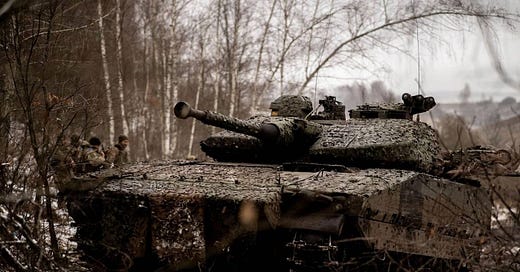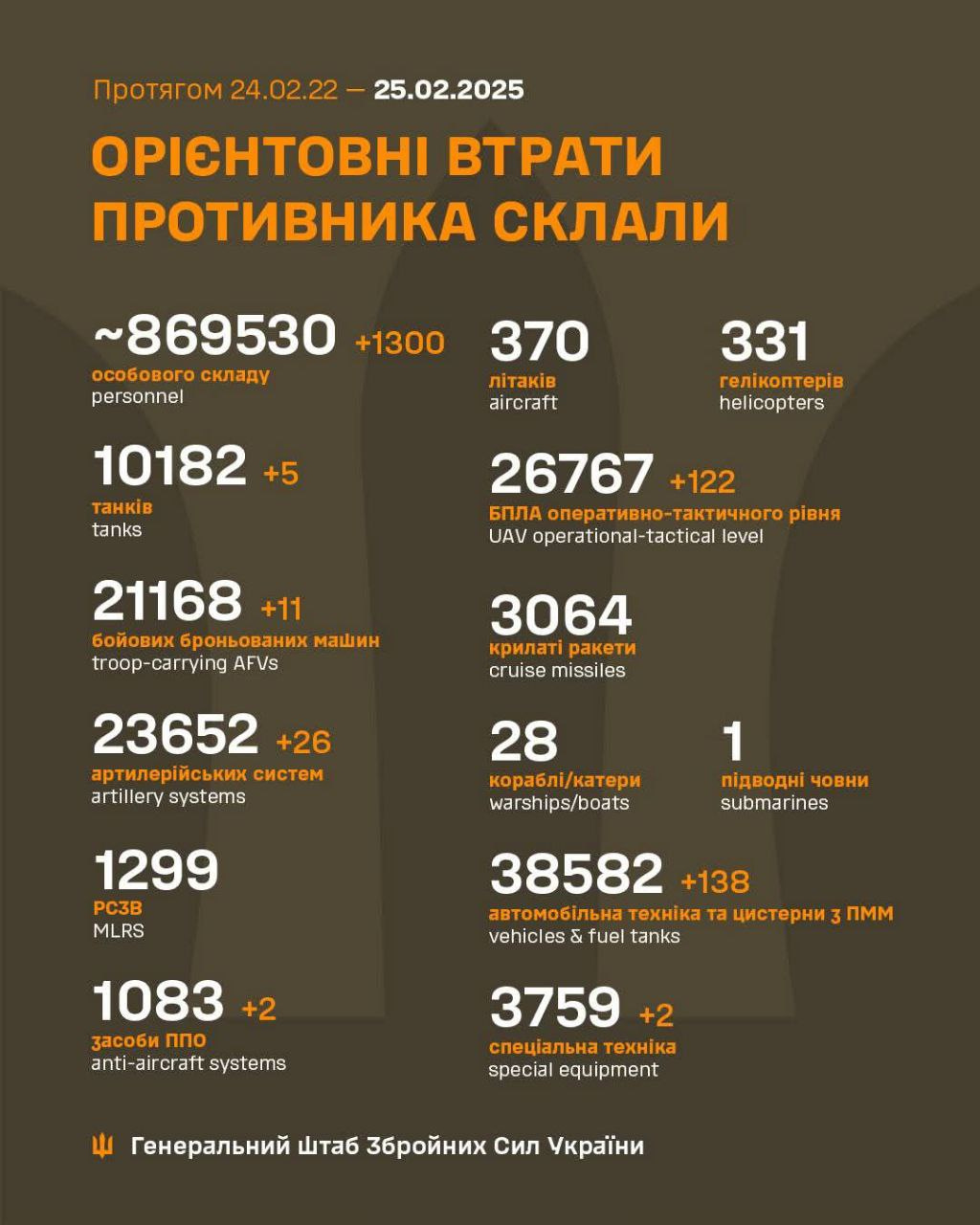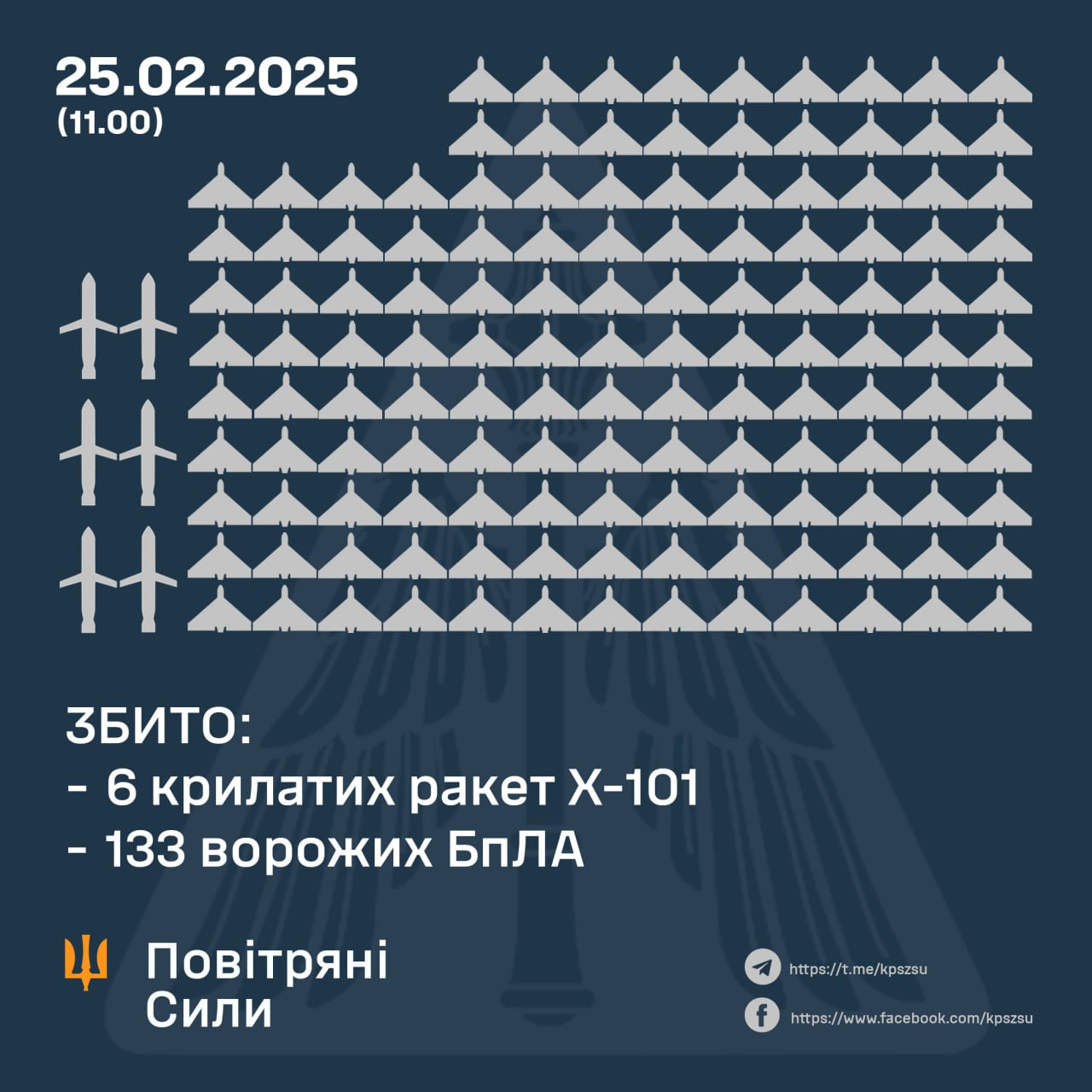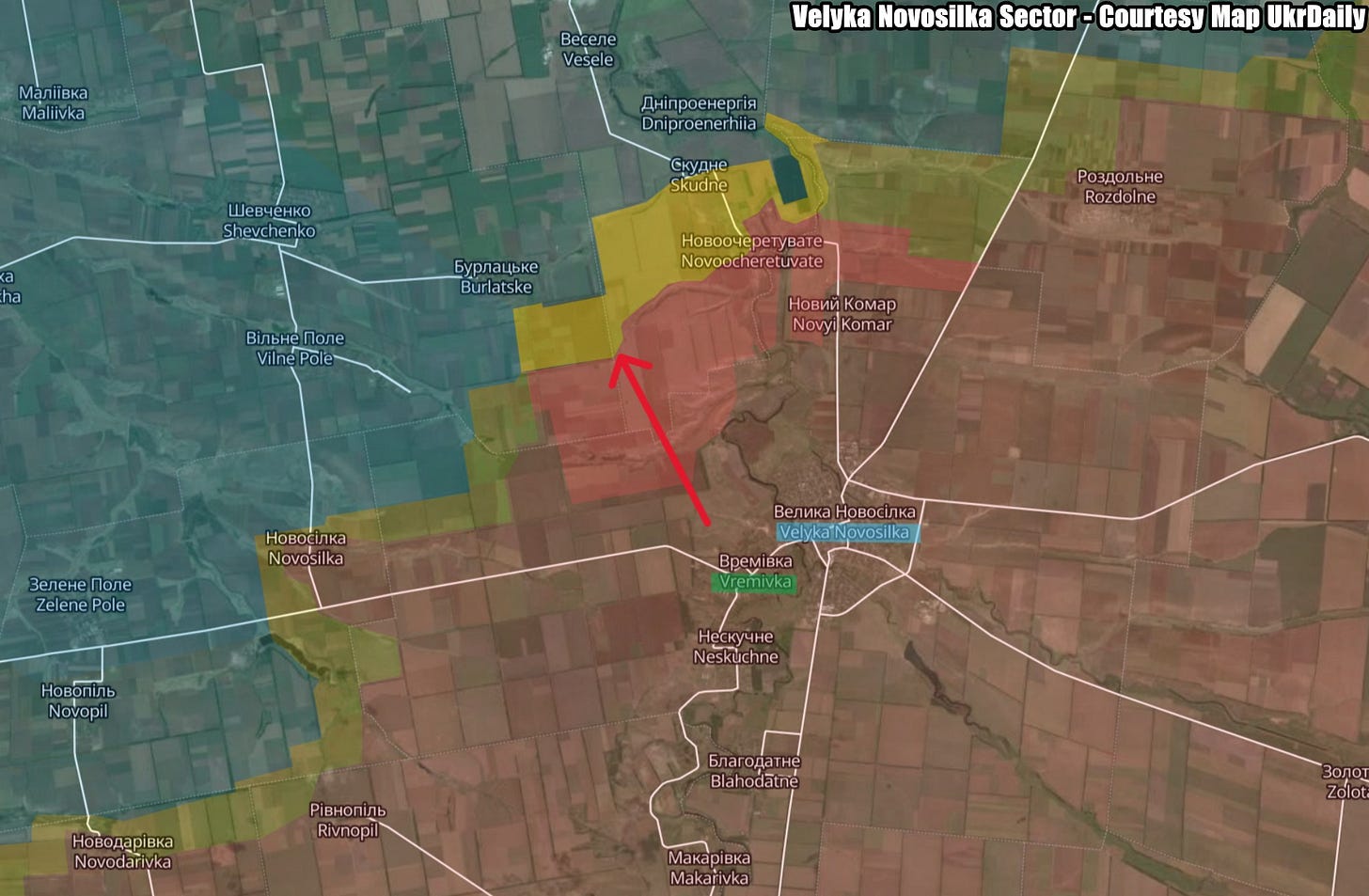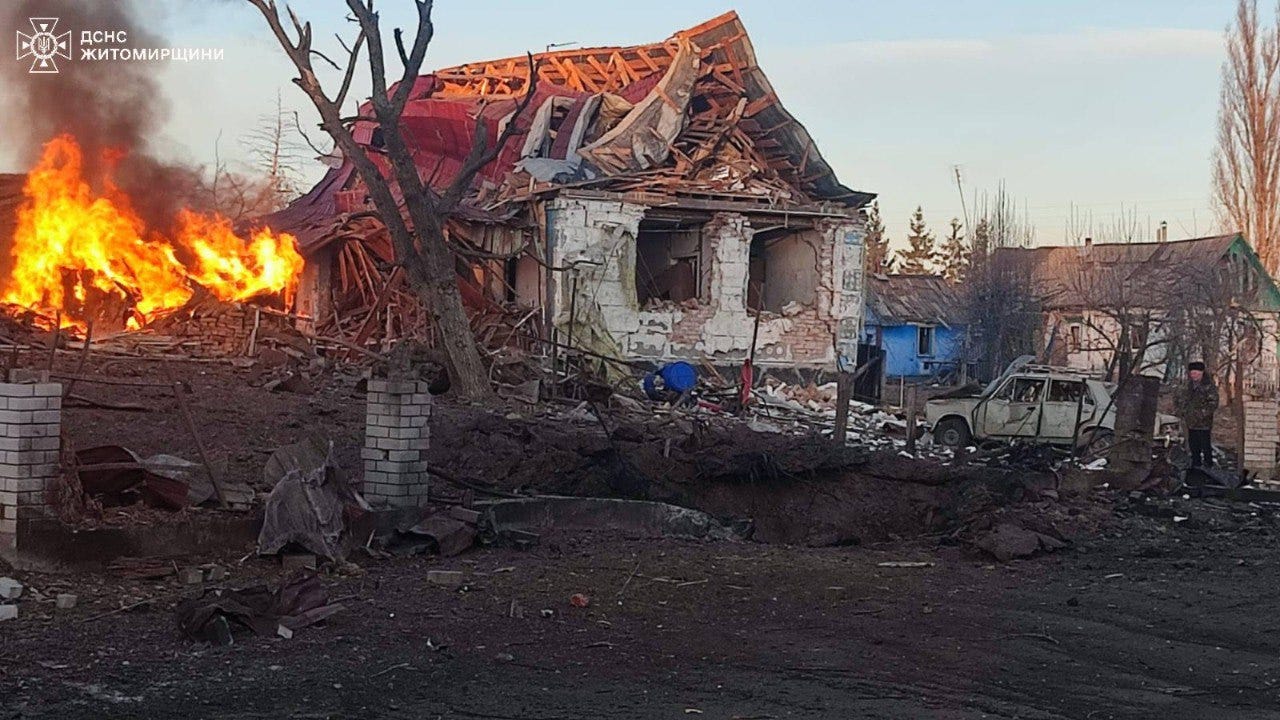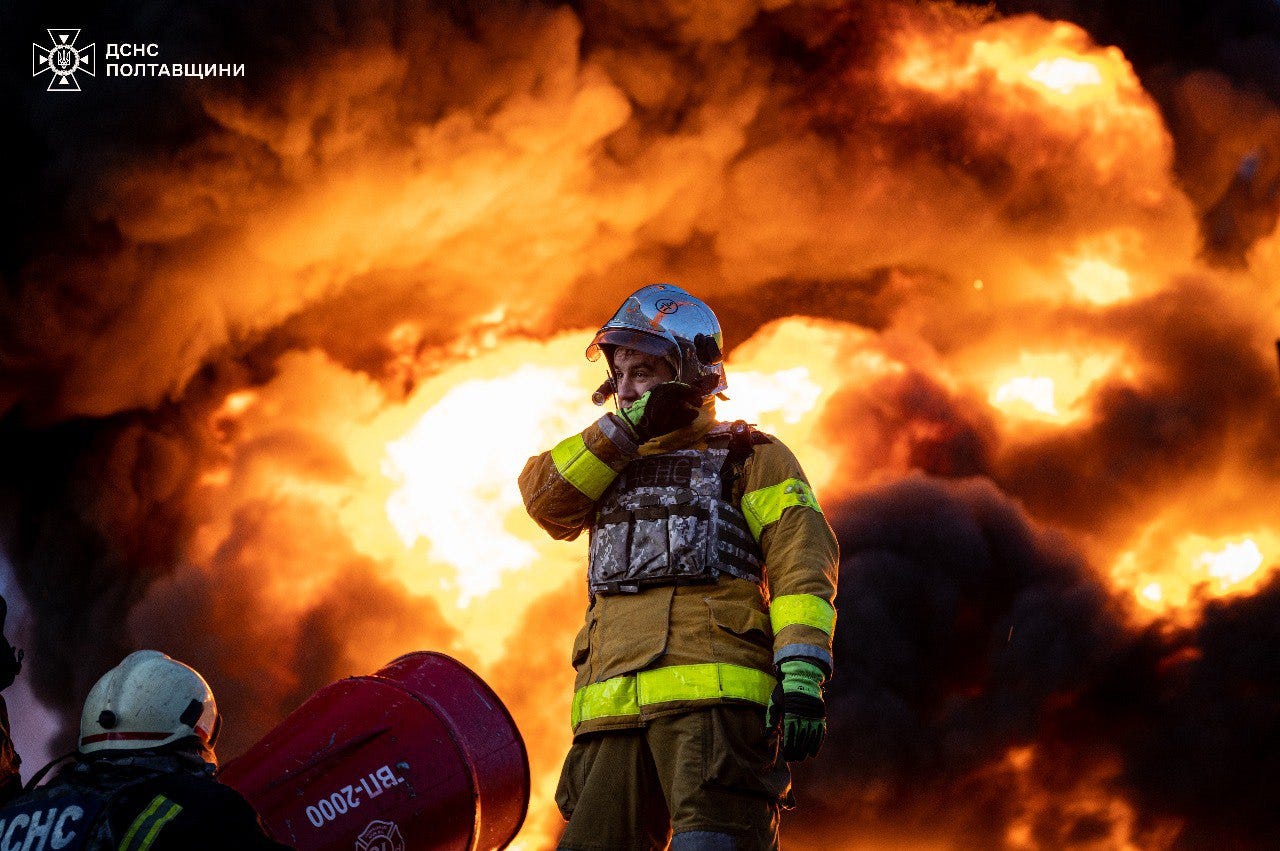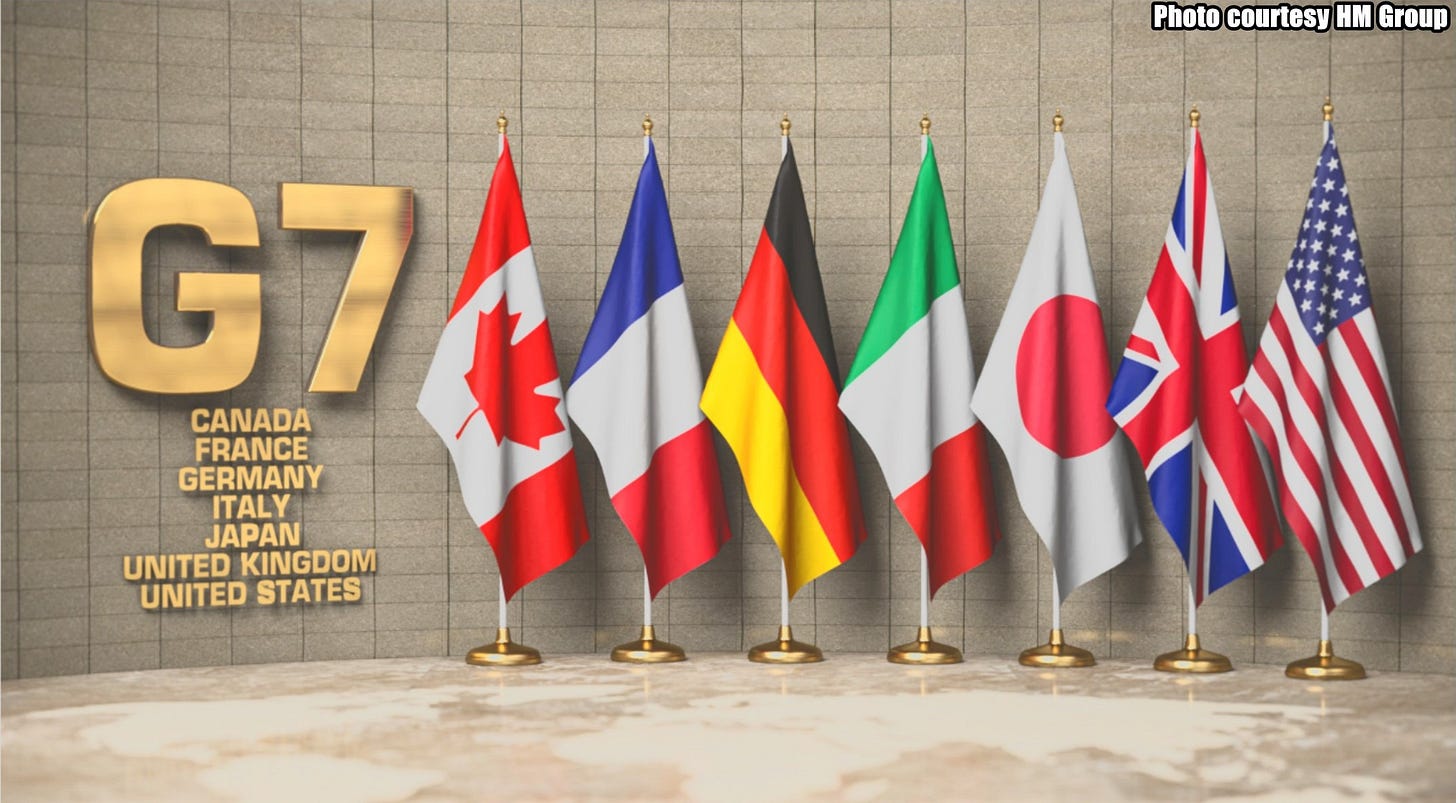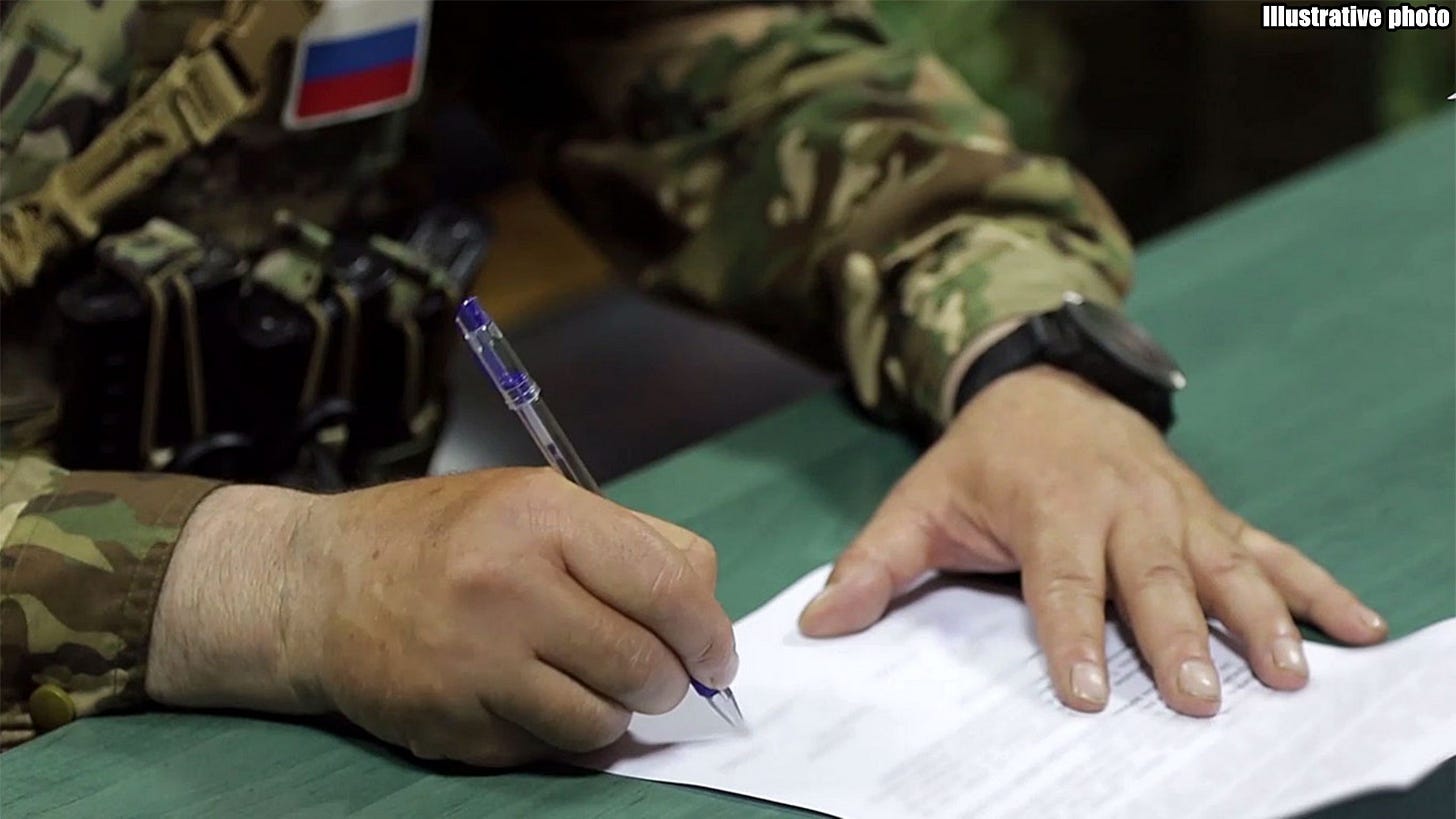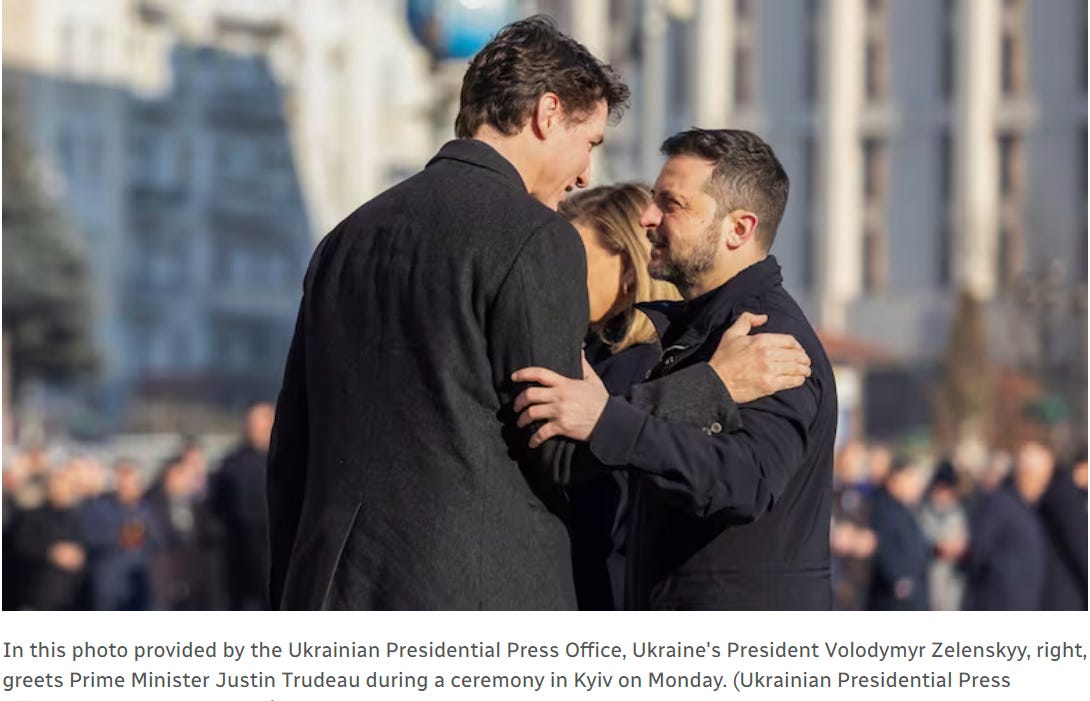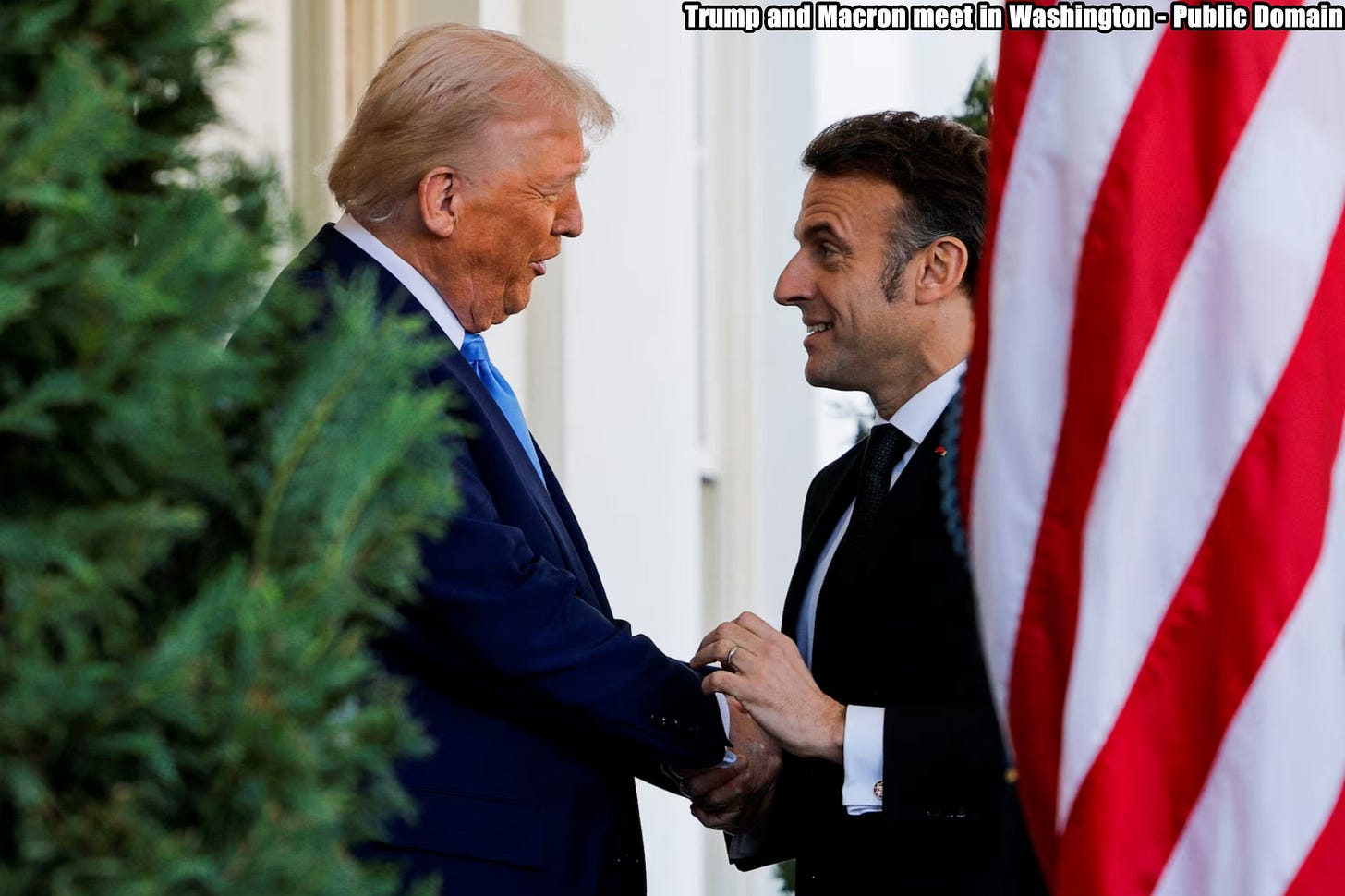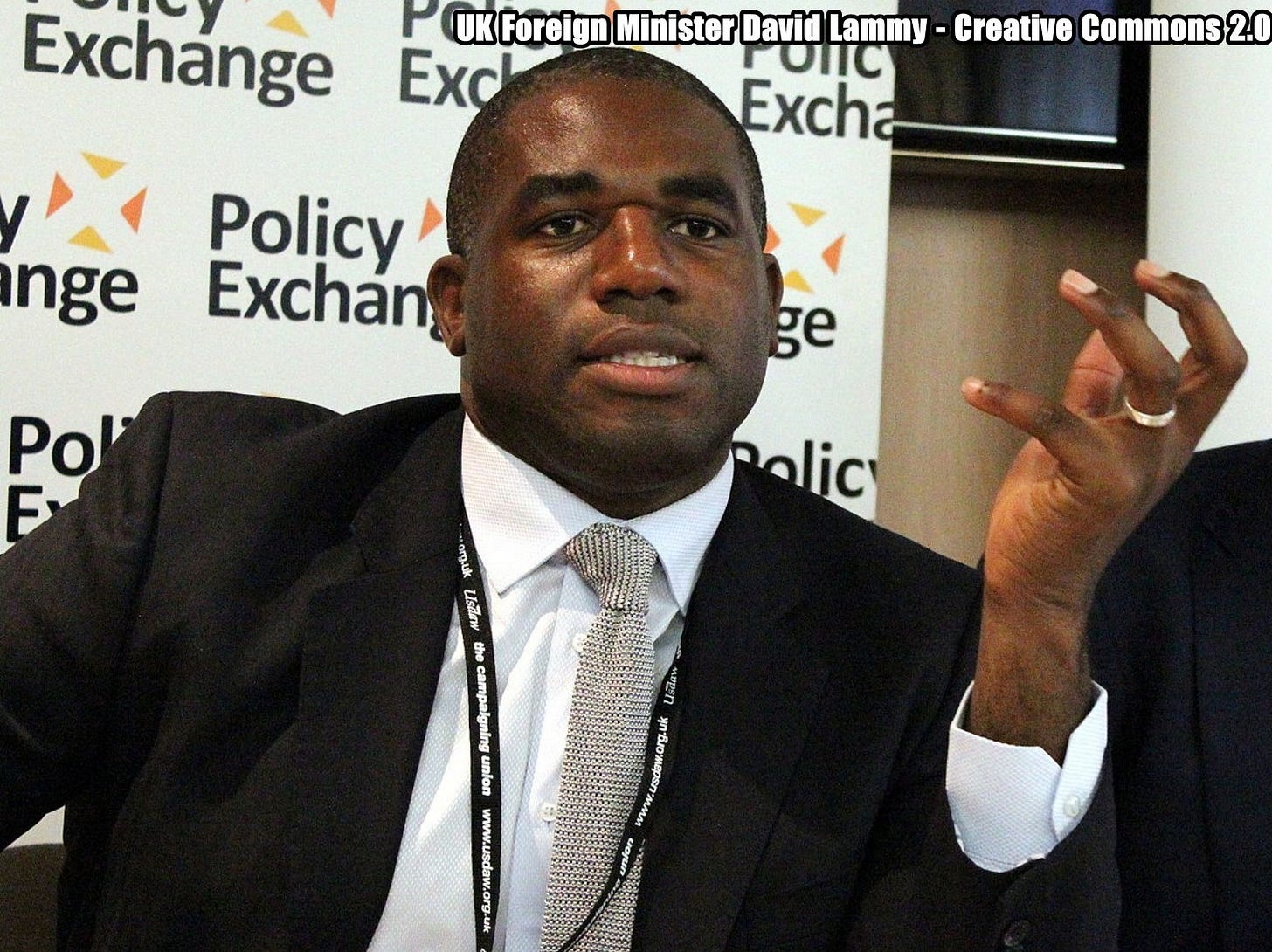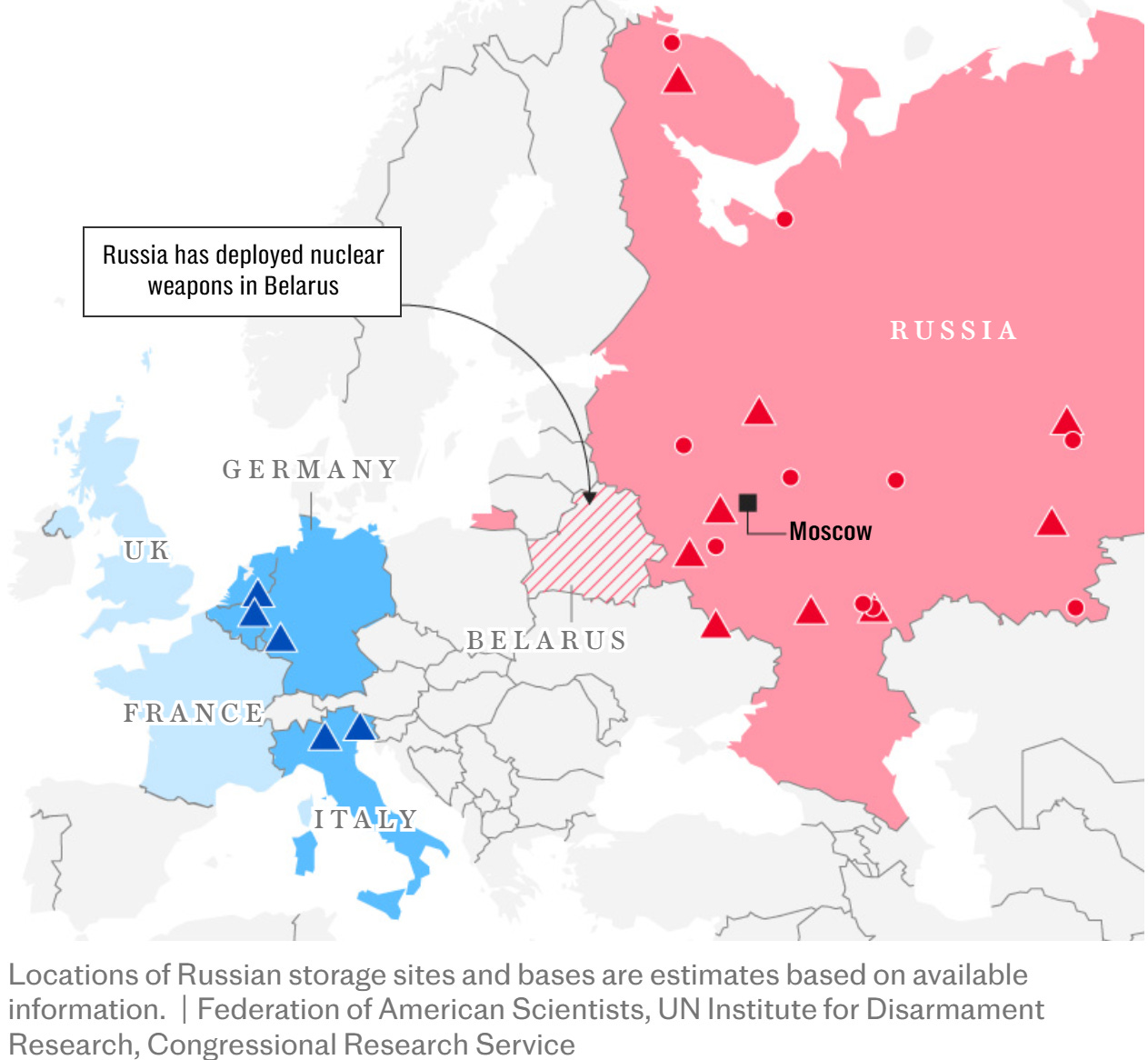Slava Ukraini! In early 2022 I began a Telegram channel aggregating news from a number of sources daily on the war in Ukraine. In June 2023 I began providing a daily draft for the Ukraine War Brief Podcast collecting news from over 70 sources daily, which formed the basis of the script. While the Podcast no longer exists I have continued to make this Brief available for my followers here on Substack for those who wish to keep up with the news from the war.
All the latest news on the Russo-Ukraine War 6 days per week
ALONG THE CONTACT LINE
GSAFU Morning Report
The General Staff of the Armed Forces of Ukraine in its Operational Information update at 08:00 on stated that day of the full-scale invasion of the Russian Federation against Ukraine had begun.
The situation on the line of combat remains tense in some sectors. Ukrainian defenders continue to actively counteract the Russian aggressor, causing them significant losses in personnel, equipment and technology. Exhausting the enemy along the entire front line and continuing to disrupt the plans of Russian occupiers to advance deeper into the territory of Ukraine.
During the past day, 98 combat engagements took place.
Over the past 24 hours, the enemy carried out missile strikes, 85 air strikes, used 2,438 drones and fired approximately 5,000 artillery shells across the positions of Ukrainian forces and civilians.
Air Force Daily Report
6 CRUISE MISSILES AND 133 ENEMY UAVS SHOT DOWN, 79 DRONES FAILED TO REACH THEIR TARGETS (LOCATIONALLY LOST)
➖➖➖➖➖➖➖➖➖
On the night of February 25, 2025 (from 19:00 on February 24), the enemy attacked with 213 Shahed attack UAVs and simulator drones of various types from the directions: Orel, Bryansk, Kursk, Primorsko-Akhtarsk - Russia, and also struck with 7 Kh-101 cruise missiles from Tu-95MS strategic aviation aircraft.
The air attack was repelled by aviation, anti-aircraft missile troops, electronic warfare units, and mobile fire groups of the Air Force and Defense Forces of Ukraine.
As of 11:00, the shooting down of 6 Kh-101 cruise missiles and 133 Shahed attack UAVs and drones of other types in Poltava, Sumy, Kyiv, Chernihiv, Cherkasy, Kirovohrad, Zhytomyr, Mykolaiv, and Dnipropetrovsk regions was confirmed.
79 enemy drones-simulators - lost in location (without negative consequences).
As a result of the enemy attack, the Kyiv and Zhytomyr regions suffered.
Combat Operations in the Kursk Sector, Russian Federation
The Institute for the Study of War (ISW), a US based think tank, in its Feb 24 Russian Offensive Campaign Assessment reported that Russian forces recently advanced in Kursk Oblast. Russian forces attacked near the international border in northeastern Sumy Oblast near Zhuravka; northwest of Sudzha near Sverdlikovo, Lebedevka, Nikolskiy, Malaya Loknya, and Pogrebki; and southeast of Sudzha near Cherkasskaya Konopelka and Fanaseyevka. A Kremlin-affiliated Russian milblogger claimed on Feb 24 that Ukrainian forces counterattacked along the H-07 Yunakivka-Sudzha road.
Geolocated footage published on Feb 23 indicates that Russian forces recently advanced in western Lebedevka.
The Khortytsia operational-strategic group
(Responsible for the northeastern part of Ukraine. )
Chasiv Yar Sector: Russian forces recently advanced in the Chasiv Yar direction. Russian forces conducted offensive operations near Chasiv Yar itself, north of Chasiv Yar toward Orikhovo-Vasylivka, and south of Chasiv Yar near Stupochky and toward Predtechyne on February 23 and 24. A Russian milblogger claimed that Ukrainian forces are counterattacking south of Chasiv Yar.
Geolocated footage published on Feb 24 indicates that Russian forces recently advanced along the T-0504 Chasiv Yar-Kostyantynivka highway east of Chasiv Yar.
The Tavria operational-strategic group
(Responsible for the central-eastern and southeastern part of Ukraine.)
Pokrovsk Sector : Russian forces recently advanced in the Pokrovsk direction. Russian forces continued assaults north Pokrovsk itself; east of Pokrovsk near Vodyane Druhe, Promin, and the T-0504 Pokrovsk-Kostyantynivka highway junction; southeast of Pokrovsk near Myrolyubivka; south of Pokrovsk near Leontovychi (formerly Pershe Travhya); and southwest of Pokrovsk near Kotlyne, Udachne, Molodetske, Nadiivka, Novooleksandrivka, Novoserhiivka, Slovyanka, Troitske, Uspenivka, Preobrazhenka, Zaporizhzhia, Yasenove, and Bohdanivka on Feb 23 and 24. Ukrainian military observer Kostyantyn Mashovets stated that Ukrainian forces continued counterattacks south and southwest of Pokrovsk.
Geolocated footage published on Feb 24 indicates that Russian forces recently advanced north of Shevchenko (southwest of Pokrovsk) along the T-0515 Pokrovsk-Andriivka highway.
Velyka Novosilka Sector: Russian forces recently advanced in the Velyka Novosilka direction. Russian forces continued attacking north of Velyka Novosilka near Novoocheretuvate, Skudne, and Dniproenerhiia; northwest of Velyka Novosilka near Burlatske; west of Velyka Novosilka near Novosilka; and southwest of Velyka Novosilka near Novopil on Feb 23 and 24.
Geolocated footage published on Feb 24 indicates that Russian forces recently advanced northwest of Vremivka (just west of Velyka Novosilka).
The Odesa operational-strategic group
(Responsible for Kherson, Qırım, (also known as Crimea) and the Black Sea.)
There have been no major changes to the combat environment since our last report.
TEMPORARILY OCCUPIED TERRITORIES
Nothing major to report.
THE HOME FRONT
Russian attacks across Ukraine kill 2, injure 36 over past day.
Russian attacks against Ukraine killed two civilians and injured 36 others over the past day, the Kyiv Independent reported citing regional authorities reported on Feb. 25.
The Russian military regularly attacks Ukrainian cities and villages with drones, missiles, glide bombs, and artillery. Despite overwhelming evidence, the Russian government has denied that its army is targeting civilians.
In Sumy Oblast, Russia struck the Sumy community with a drone, injuring two people overnight on Feb. 25, the local military administration reported.
The day prior, Russia targeted Velykapysarivka with artillery, drones, and mortars. One person was killed, and two others were injured in the attacks.
In Myropillia, Russian forces struck the settlements with a glide bomb, drones, and mortars, injuring three civilians.
In Donetsk Oblast, Russian strikes killed one person and injured two others in the town of Sloviansk. In Kramatorsk, two people suffered injuries and one person was injured in Kostiantynivka.
One civilian was also injured in the attack against the village of Fedorivka, Governor Vadym Filashkin reported.
In Kherson Oblast, Russia targeted 34 settlements, including the regional center of Kherson, over the past day. As a result of the attacks, 13 people, including a child, were injured, Governor Oleksandr Prokudin reported.
As of Feb. 25 morning, Russian forces struck Kherson again, injuring a 63-year-old man. He suffered a shrapnel wound to his leg and an explosive injury.
In Kharkiv Oblast, a Russian glide bomb struck the town of Derhachi, injuring four women, according to Governor Oleh Syniehubov. Russian forces also attacked the village of Tsupivka, injuring four civilians.
In Kyiv Oblast, Russian forces attacked several settlements with drones. A 44-year-old woman suffered leg injuries in the Obukhiv district, the local military administration reported.
RUSSIAN WORLD
Russia will not be readmitted to G7, German finance minister says.
Russia will not be readmitted to the Group of Seven (G7),Reuters reports citing Germany's finance minister, Joerg Kukies, on Feb. 25, despite U.S. President Donald Trump.
"The condemnation of the G7 of Russia's war of aggression is very clear, especially on the third anniversary of Russia's brutal attack," Kukies said.
Trump said on Feb. 13 that he would "love" to see Russia readmitted into the G7, calling Russia's 2014 expulsion from the group a "mistake."
"I'd love to have them back. I think it was a mistake to throw them out," Trump told reporters in the Oval Office.
"Look, it's not a question of liking Russia or not liking Russia. It was the G8," Trump said, referring to the former name of the international forum.
Then-Group of Eight (G8) countries expelled Russia from the group in 2014 after it invaded parts of eastern Ukraine and annexed Crimea.
Since the start of Russia's full-scale invasion of Ukraine, G7 countries have collectively supported Ukraine with military and financial aid.
But cracks have been showing in recent days after the U.S.'s abrupt shift away from Ukraine since Trump took office last month.
The G7 is still discussing a joint statement on the third anniversary of Russia's full-scale invasion of Ukraine due to disagreements with the U.S., Reuters reported on Feb. 25, citing Canadian Foreign Minister Melanie Joly.
"We've been working, indeed, with the Europeans and Americans. We are still having some conversations," Joly said during the briefing when asked about the statement's status.
Joly's statement comes after the U.S. joined Russia and Belarus in voting against a U.N. resolution condemning Russia's full-scale invasion on Feb. 24.
"Canada and other countries don't agree with the position that the U.S. advocated at the UN, particularly the resolution they brought up," Joly said.
Washington also opposes the wording "Russian aggression" in any joint G7 statement on the war, according to Reuters.
Russian Commanders Coercing Soldiers into Signing Indefinite Contracts.
The UK Ministry of Defence in their Feb 21 Intelligence Update on Ukraine stated that Russian military commanders are ‘forcing’ men mobilised in 2022 to sign contracts with the Russian Ministry of Defence, according to independent Russian media outlet Verstka.
Whilst contracts given to Russian soldiers are said to have formal end dates, they can reportedly run indefinitely, with those who refuse to sign threatened with being sent into ‘meat grinder’ assaults with survival rates as low as 10-15 per cent.
Russian efforts to coerce mobilised soldiers to sign indefinite contracts are highly likely motivated in part by a lack of experienced soldiers, with Russia having sustained approximately 860,000 killed and wounded since invading Ukraine in 2022. This has severely depleted the number of Russian personnel with more than rudimentary levels of training.
Russia’s leadership also almost certainly perceives such measures as reducing the potential requirement for further domestically unpopular mobilizations. After Vladimir Putin’s announcement of the partial mobilization in 2022, hundreds of thousands of young and educated Russians chose to leave the country rather than participate in the illegal Russian invasion. This has substantially contributed to long-term difficulties for Russia's labour market.
INTERNATIONAL NEWS
Europe and US clash over Ukraine in G7 and UN.
The US and Europe are battling in the UN and G7 over whether to blame Russia for its war against Ukraine, as President Donald Trump’s rapid shift on the conflict threatens to tear apart western unity. Financial Times reported on Feb 24.
The Trump administration and the EU have proposed rival UN resolutions at the Security Council and General Assembly on Monday, while G7 diplomats spent the weekend haggling over whether a joint statement due to be released by the group of rich nations would refer to Russia’s “aggression” against Ukraine or not.
Officials said that, without a last-minute compromise, the US could side with Russia and China to prevent a western European-backed show of support for Kyiv.
“If [we] look at the messages that come from the United States, then it is clear that the Russian narrative is, there, very strongly represented,” EU chief diplomat Kaja Kallas told reporters on Monday when asked if she believed the Trump administration was acting in Russia’s interests.
Trump’s push for a rapid end to the war, his opening of bilateral peace talks with Russia and his escalating war of words with Ukrainian President Volodymyr Zelenskyy have torn up three years of united western condemnations of Moscow’s invasion in February 2022 and the brutal war that followed.
In a move to commemorate the war’s third anniversary, Ukraine and the EU have co-authored a UN resolution condemning Russia’s invasion, which is set for a vote by the general assembly’s 193 members on Monday afternoon.
The US has called for that resolution to be withdrawn, according to two officials briefed on the discussions. Washington has instead proposed its own text, which equates Ukraine’s actions with Russia’s, mourning “tragic loss of life throughout the Russian Federation-Ukraine conflict”, according to a draft of the resolution viewed by the FT.
“This [US] wording is obviously unacceptable to us,” said the official. “It’s all linked together and part of the wider shift in position by the US.
The US draft resolution, which is just three paragraphs long, stops short of calling for a ceasefire but urges “peace” on unspecified terms. “There’s nothing in the resolution that limits what conversations and situations can occur after the fact,” a State Department official said.
Speaking during Monday’s General Assembly debate, US representative Dorothy Camille Shea said the country “cannot support Ukraine’s resolution and we urge its withdrawal . . . This war must end now.”
France, backed by European allies, has proposed an amendment to the US resolution that refers to “Russia’s invasion of Ukraine” and “the sovereignty, independence, unity and territorial integrity of Ukraine”, according to a document seen by the Financial Times.
If that amendment is not accepted, the majority of European countries would not vote in favour of the resolution, the officials warned, while acknowledging some could split from the EU position to back the US.
Two of the officials added that European members will again propose the amendment when the Security Council meets later on in the afternoon — but said its inclusion could be vetoed by Russia and China.
A State Department official said the US would veto any amendments introduced to its resolution.
France and the UK — which are both permanent members of the 15-member council — could then have to decide between using their own vetoes to block the US resolution or abstaining and letting it go through.
The G7 also held a virtual leaders meeting on Ukraine on Monday.
A person briefed on the negotiations said there had been an “agreement in principle” on a compromise G7 text on the issue, but that Trump subsequently decided it should be dependent on the UN resolutions.
The US last week refused to agree to a G7 statement that referred to “Russian aggression” against Ukraine. US defence secretary Pete Hegseth echoed that position at the weekend.
“Fair to say it’s a very complicated situation,” he told Fox News Sunday when asked if it was “fair” to say that Russia invaded Ukraine.
The Kremlin said it “welcomed and supported” the US “reformatting” of its approach to Russia.
“We can indeed see Washington is attempting to work out what the initial reason for this conflict was, and we hope this analysis will help efforts to settle the conflict,” Dmitry Peskov, President Vladimir Putin’s spokesperson, told reporters on Monday, according to the Interfax news agency.
The White House is also pushing for a deal with Ukraine to develop its natural resources and critical minerals, arguing the plan would fuel postwar growth in the country and did not involve any coercive economic pressure.
Deputy prime minister Olha Stefanishyna said on Monday that Kyiv and Washington were in the “final stage” of what has been intense, week-long negotiations during which Ukraine has tried to get the US side to include future security guarantees.
But the latest draft proposal dated February 24 and viewed by the FT still did not include the obligation of future US security assistance for Kyiv.
The diplomatic efforts to avoid further public rifts between the US and its European allies come as French President Emmanuel Macron is due to meet Trump in the White House on Monday, the first such visit by a European leader since the US president’s election.
UK Prime Minister Sir Keir Starmer is also scheduled to see Trump on Thursday and London is keen to avoid stoking a fight with the US president beforehand. Starmer has praised Trump for having “changed the global conversation” on Ukraine.
Trudeau says 'everything is on the table' when it comes to putting boots on the ground to enforce peace deal.
Prime Minister Justin Trudeau paid a surprise visit to Kyiv on Monday, along with other Western political leaders, to mark the third anniversary of Russia's full-scale invasion of Ukraine. CBC News reports.
It is an important, symbolic moment and comes less than a week after U.S. President Donald Trump's public attacks on Ukrainian President Volodymyr Zelenskyy, whom Trump dismissed as a "dictator."
Trudeau opened the summit pledging to give 25 light-armoured vehicles to Ukraine and to provide the country with the first payment of the $5 billion in funds from seized Russian assets.
The money is being channelled through the Extraordinary Revenue Acceleration (ERA) loans for Ukraine program, which saw G7 countries agree last year to using Russian assets to help Ukraine rebuild. The Prime Minister's Office says the entire initiative will provide Ukraine with almost $70 billion.
Trudeau also said Canada will be delivering two armoured combat support vehicles that Ukrainian forces will begin training on shortly in Germany.
The prime minister also said Canada will provide a grant to help Ukraine with energy security as Russia attacks the country's power grid. Trudeau also announced new assistance for Ukraine totalling $118.5 million in humanitarian aid.
Trudeau announced new sanctions targeting 76 individuals and entities who the government says are providing support to Russia's military, are involved in the forced transfer of Ukrainian children or support Russian President Vladimir Putin's regime.
The prime minister also announced Canada is sanctioning 109 vessels based on their involvement in transferring sanctioned Russian goods, including hydrocarbons, saying that revenue fuels Russia's war machine.
Trump, Macron display stark differences on Ukraine despite friendly veneer.
U.S. President Donald Trump and French President Emmanuel Macron displayed stark differences on Monday in their approach to Ukraine, exposing a divide between the United States and Europe over Trump's bid for a quick ceasefire deal with Russia. Reuters reported.
During a day of talks between the two leaders, Trump and Macron showed a friendly rapport based on years of good ties. But Macron made clear he disagreed with Trump on some key issues as they marked three years since Russia invaded Ukraine in 2022.
Trump refused to refer to Russian President Vladimir Putin as a dictator, after calling Ukraine President Volodymyr Zelenskyy a dictator last week. Macron said it was clear that Russia "is the aggressor" in the conflict, a topic Trump wavered on last week.
"President Putin violated the peace," Macron said at a joint press conference with Trump.
Trump expressed a desire for a ceasefire as soon as possible and said he was trying to arrange one between Ukraine and Russia. He said he could go to Moscow to meet Putin once a deal is reached.
Macron, on the other hand, urged a more deliberate approach, starting with a truce and then a peace deal that includes security guarantees.
"We want peace, he wants peace. We want peace swiftly, but we don't want an agreement that is weak," Macron told reporters. Any peace deal, he said, must be "assessed, checked and verified."
The two leaders did agree, however, on the deployment of European peacekeeping forces once a peace deal is eventually reached.
"They would not be along the front lines. They would not be part of any conflict. They would be there to ensure that the peace is respected," Macron said earlier in the Oval Office with Trump.
Trump said he accepts the concept, as does Putin.
"Yeah, he will accept that," Trump said about Putin's position on a peacekeeping force. "I specifically asked him that question. He has no problem with it."
Macron, the first European leader to visit Trump since he regained power a month ago, called his discussions with Trump "a turning point" in the drive for a more unified approach.
Macron is trying to capitalize on a relationship with Trump built during their first presidential terms. The French leader showed how he has managed to deal with the unpredictable Trump without alienating him.
At one point during their Oval Office meeting, Macron touched Trump's arm and carefully corrected the U.S. president's claim that Europe had delivered all of its aid as loans.
Trump reported progress on reaching a revenue-sharing agreement with Ukraine on Ukrainian minerals as a way to recoup the cost of weaponry pumped into Ukraine by the previous Biden administration. Trump said he expected Zelenskyy to come to the United States this week or next week to seal the agreement.
Trump and his team have been negotiating a minerals revenue-sharing agreement with Ukraine to recoup some of the money that the previous Biden administration had sent to Kyiv in the form of weapons to repel Russia.
Zelenskyy last week rejected U.S. demands for $500 billion in mineral wealth from Ukraine to repay Washington for wartime aid, saying the United States had supplied nowhere near that sum so far and offered no specific security guarantees in the agreement.
Trump, asked if it was possible that Ukraine might have to cede some territory to Russia, said, "Well, we're going to see." Macron said any deal should include sovereignty for Ukraine.
British Prime Minister Keir Starmer also is to visit Trump later in the week, amid alarm in Europe over Trump's hardening stance toward Ukraine and overtures to Moscow on the conflict.
UK Foreign Minister: It's time to seize Russian assets, not just freeze them.
Europe should move from freezing Russian assets to seizing them, British foreign minister David Lammy said on Tuesday. Reuters reported.
"It's not an issue on which any government can act alone. We must act with European allies," Lammy told parliament, saying the issue had been discussed between G7 and other international allies.
"Of course, Europe has to act quickly, and I believe we should move from freezing assets to seizing assets."
French nuclear shield could extend across Europe.
France is ready to use its nuclear deterrent to help protect Europe, The Telegraph reports.
Fighter jets carrying nuclear weapons could be deployed to Germany as the US threatens to withdraw its forces from the Continent.
Friedrich Merz, expected to be the next German chancellor after winning his country’s elections on Sunday, has called on Britain and France to extend their nuclear protection as he seeks “independence” for Europe from Donald Trump’s America.
A French official told The Telegraph that deploying fighter jets would send a message to Vladimir Putin, while diplomats in Berlin suggested it would pressure Sir Keir Starmer to do the same.
“Posting a few French nuclear jet fighters in Germany should not be difficult and would send a strong message,” the source said.
Emmanuel Macron, the French president, spoke with Mr Merz on Sunday night before travelling to the White House to present his plan for European security and the defence of Ukraine to Mr Trump.
At the White House summit, held on the third anniversary of the war, the US president suggested his country would not provide security guarantees to Ukraine after a peace deal was signed.
Speaking alongside Mr Trump at the podium, Mr Macron said peace “must not be a surrender of Ukraine” as he also called on Europeans to do more to protect the Continent.
Meanwhile, the US clashed with its allies over a UN resolution on the Ukraine war. Washington voted with Russia against a motion that condemned Putin’s war and called for his forces to be withdrawn.
The United States has long guaranteed Europe’s safety with an arsenal of around 100 nuclear missiles, many of them stationed in a US military base in Germany.
France’s nuclear deterrent is currently independent from Nato, while Britain’s forms a key part of the alliance’s defence strategy.
Mr Merz said last Friday that Paris and London should discuss “whether their nuclear protection could also be extended to us” before warning on Sunday that the US under Mr Trump was now “indifferent to the fate of Europe”.
On a visit to Kyiv on Monday, Boris Johnson, the former UK prime minister, told The Telegraph there was a “moral case” for Ukraine to have its own nuclear weapons as the threat from Russia rises.
MILITARY & TECH
Russian IFV’s Are Death Traps
This is a combination of two articles from Defence Blog citing serious design flaws with the BMP 2 and 3 that are costing the lives of Russian forces.
Russia’s BMP-2: a death trap for troops
(1) The ongoing war in Ukraine has exposed the severe shortcomings of Soviet-designed infantry fighting vehicles (IFVs), particularly the BMP-2.
Russian forces have been forced to implement makeshift modifications to compensate for these flaws, attempting to increase their chances of survival in combat.
Recently, images have surfaced showing upgraded BMP-2 vehicles with large external troop compartments mounted atop the vehicle’s hull. These modifications stem from the inherent discomfort and cramped conditions inside the standard troop compartment, forcing soldiers to build larger structures with wider doors for easier dismounting.
This practice is reminiscent of tactics dating back to the Soviet-Afghan War when troops commonly rode on top of armored vehicles. It is believed that sitting atop the vehicle increases the chances of survival in the event of an RPG strike or an anti-tank mine explosion, as it prevents soldiers from being trapped inside a burning or destroyed vehicle.
Due to the vulnerability of BMP-2 vehicles, Russian soldiers often opt to ride on the roof rather than inside. This adaptation is an attempt to mitigate the risk of casualties caused by the vehicle’s poor protection against mines and anti-tank weapons.
In direct battlefield comparisons, the outdated BMP-2 has proven inferior to even older Western armored personnel carriers, such as the American M113. Despite its aluminum armor, the M113 offers better maneuverability, troop comfort, and ease of maintenance. The BMP-2’s hull consists of multiple welded steel plates arranged at various angles, a complex structure that offers no significant protective advantage. The vehicle’s armor is just 10mm thick, insufficient against modern threats. In contrast, the M113’s front armor is 38mm thick, while the BMP-2’s frontal plate is only 15mm.
Moreover, in the event of an anti-tank weapon strike or mine detonation, the BMP-2’s crew and passengers are far more likely to suffer fatal consequences compared to those inside M113s—or even more so compared to the heavily armored American Bradley IFV, which has gained a strong reputation for battlefield survivability.
The BMP-2’s design is particularly ill-suited to dealing with mine threats. The left front road wheel is positioned in such a way that if the vehicle runs over a mine, the driver is almost always killed instantly.
While Soviet-era IFVs were once valued for their low production costs, Russia’s struggling economy and limited industrial capacity have hindered large-scale production of both BMP-2 and its intended successor, the BMP-3. The latter, designed as an improvement, still suffers from many of the same fundamental flaws, which continue to drive Russian troops to prefer riding on top rather than inside.
According to open-source intelligence website Oryx, Russia has lost 886 BMP-1, 1,471 BMP-2, and 427 modern BMP-3 IFVs, further demonstrating the vulnerability of these vehicles in modern warfare.
The realities of the battlefield have underscored the deficiencies of Soviet-era armored vehicles, further highlighting the gap between aging designs and modern combat requirements.
Pro-Russian media slam BMP-3 design flaws
(2) Even Russian pro-government media outlets have begun criticizing the country’s engineers for yet another questionable technical decision regarding the BMP-3 infantry fighting vehicle.
The Telegram channel Voeniy Osvedomitely, known for its ties to the Russian military, has shared photos of an upgraded BMP-3, revealing controversial modifications.
The images showcase an attempt by engineers from the Omsk Higher Tank Engineering School to equip the BMP-3 with anti-drone protection. However, this modification appears to significantly impact the vehicle’s functionality.
The troop compartment, which is designed to open upwards, is now obstructed, rendering the BMP-3 incapable of serving its intended role as an infantry fighting vehicle.
Notably, next to the modified BMP-3 in the images is a captured American Bradley infantry fighting vehicle.
“Next to the ‘Troika,’ [BMP-3] a captured American Bradley is displayed, from which domestic designers could learn a lot—at least in terms of protection and layout,” the statement said.
The critique from even pro-Russian sources reflects growing dissatisfaction with the effectiveness of certain military adaptations. As the war continues, such engineering decisions raise questions about the actual battlefield utility of these modifications.
That’s it for today’s Brief folks if you would like to keep up with events in Ukraine daily please consider subscribing, it’s free!


